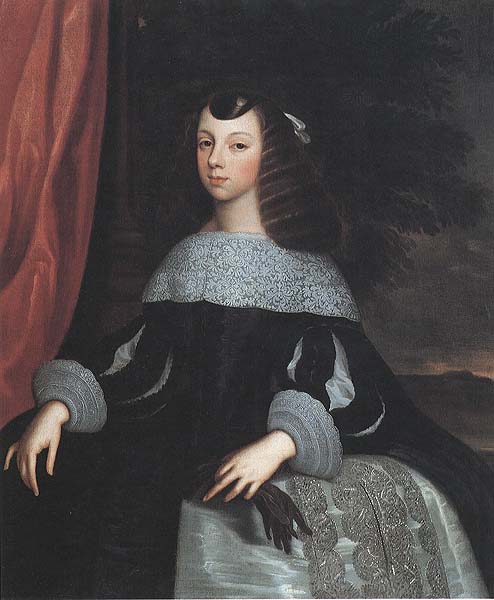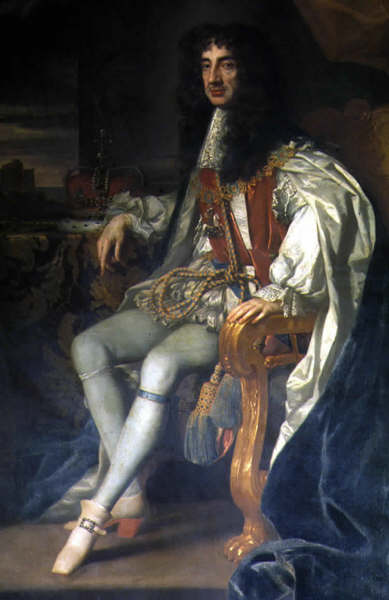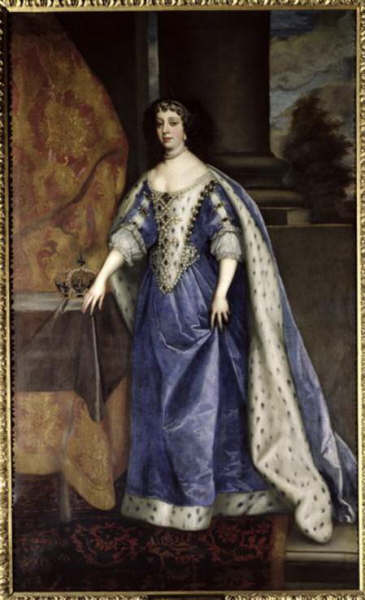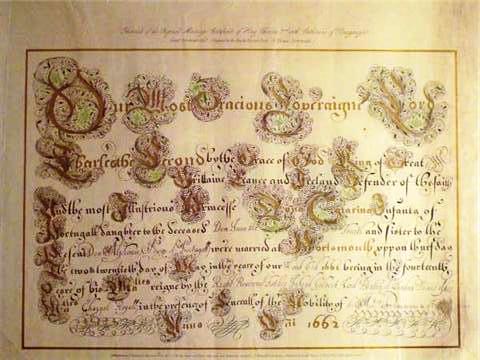May 21, 2009 marked the 347th Anniversary of the marriage of the Portuguese Infanta, Catherine of Braganza to King Charles II of England. The ceremony took place in the presence chamber at King’s House in Portsmouth before members of the English court and the large retinue of Portuguese grandees and noblewoman, who had accompanied the bride to her new home in England.
In our view, Catherine of Braganza has been subject to some neglect in the annals of British and Portuguese history alike. Of all the Queens of the United Kingdom of England, Scotland and Ireland, she has been one of the most forgotten, despite the fact that her reign as Queen-Consort to Charles Stuart, the Merry Monarch, was to have a profound influence on the history of Britain and the British people at home and abroad. Her marriage to Charles II in 1662, shortly after his Restoration to the throne, reshaped the political, economic, territorial and cultural fabric of Britain, and provided a new and reformed geopolitical matrix for the British Empire that ensued.
 |
Portrait of the young Catherine of Braganza shortly after her arrival in England
(By Dirk Stoop)
|
Catherine, Infanta of Portugal, was born on 25th November 1638 at the ducal palace of Vila Viçosa, the fourth child of the John, Duke of Braganza, and his Spanish spouse, Luisa de Guzman, of the Spanish House of Medina-Sidonia. At the time of her birth, Portugal was in a volatile state of political and social upheaval due to the fact that the Portuguese people had never fully accepted their Spanish overlords, who had inherited the Portuguese throne in the wake of the succession crisis that followed the defeat and disappearance of the young and unmarried King Sebastian of Portugal at the Battle of Alcacer Quibir in North Africa in 1578.
In 1640, after sixty years of unwelcome Spanish dominance known as the Phillipine Era, her father, a direct descendant of Manuel I, was popularly acclaimed King of Portugal. The ascendance of John IV to the Portuguese throne marked the beginning of a period in Portuguese history known as the Restauração or Restoration, and the implantation of a new dynasty, the House of Braganza.
This change in the destiny of her family meant that Catherine, then only two years old, was now raised to the position of Infanta of Portugal.
 |
| Charles II, spouse to Catherine of Braganza and King of England, Scotland and Ireland (By Sir Peter Lely) |
With the death of her father in 1656, her younger brother succeeded to the throne as King Alfonse VI. As the new king was both mentally and physically incompetent, the Dowager Queen, Luisa de Guzman, became Regent and effectively ruled the country on her son’s behalf. A wise and astute stateswoman, Dona Luisa was aware of the advantages that a marriage of her daughter Catherine to the then exiled heir to English throne, Charles Stuart, would bring to the fragile, newly-restored Portuguese monarchy, which was beleaguered by the constant threat of Spanish invasion.
In 1660, Charles Stuart was restored to the English throne and soon thereafter began an earnest search for a suitable spouse among the Royal Houses of Europe. The Cromwellian Commonwealth and Protectorate had depleted the coffers of the State, and the country faced financial ruin. Therefore, it was in Charles II’s interest to find a wife that would not only provide Britain with a strategic political alliance, but also replenish his fast-dwindling Treasury. Aware that Portugal would not be able to buffer the Spanish threat on its own, Dona Luisa sought to strengthen Portugal’s military and political position by seeking out an alliance with another of Spain’s foes, England, by offering her daughter’s hand in marriage to the newly crowned English monarch. To this end, she offered the largest dowry known in European history to date, namely £500,000 Sterling and the Portuguese territories of Tangier in North Africa and the Island of Bombay in India. Despite his commitment to reign as a Protestant monarch, Charles II agreed to espouse the Catholic Infanta of Portugal, and the couple were married in Portsmouth on 21st May 1662 (although the Marriage Certificate, held at St. Thomas, Portsmouth, inaccurately states the date as being the 22nd May).
 |
| Catherine of Braganza, Queen of England, Scotland and Ireland (By Sir Peter Lely) |
The territories brought under British sovereignty by Catherine’s marriage to Charles II provided strongholds for the British in North Africa and the Indian subcontinent. These strategic outposts were to prove very valuable and crucial to British political and economic expansionism, laying out the foundations for the Raj in India and the projection of British influence in the Arab world. Also, it favoured British trade, with the establishment of British wine and sugar merchants in Madeira, an archipelago situated off the North-Western coast of Africa, the rights and levies of which Catherine had inherited upon her father’s demise.
Furthermore, the special trade privileges the Marriage Treaty granted to the British in Brazil were the foundation for British military and economic enterprise in South America in the centuries that followed. Catherine of Braganza introduced new and lasting culinary habits to the English Court over which she presided as Queen-consort: afternoon tea, marmalade, tangerines from Tangier, porcelain, the use of spices and the fork. A great lover of music - a passion she had shared with her father – Catherine of Braganza was patron to many British composers of the day, her personal Chapel at St. James Palace and Somerset House being synonymous with musical excellence and the arts. Her patronage ensured the introduction of Italian and Portuguese musicianship in Britain during the Baroque Period. In her day, Catherine also left her imprint on English fashion by donning men’s garb when out exercising or riding, and by wearing shorter skirts that revealed her shapely ankles. She developed a love for archery and was patroness of “The Archers' Company of the honourable Artillery Company", to whom she presented a large silver shield, now in the possession of the Royal Toxophilite Society.
 |
Nineteenth century lithograph of the Royal Couple's Marriage Certificate
|
Based upon the rather unflattering and oftentimes demeaning comments about her physical and intellectual attributes found in Pepys’ Diary and the Earl of Clarendon’s correspondence, Catherine has been all too often and erroneously portrayed as an insipid, insignificant Queen, even by some renowned contemporary authors. The King’s own personal correspondence and comments upon his deathbed paint a very different picture of Catherine of Braganza: that of a sagacious, virtuous, loyal and loving spouse, counsellor and confidante, whose unwavering support was a source of great comfort and solace to a king all too frequently embattled with Court intrigue and the Parliamentary demands of a newly-fledged constitutional monarchy. The King was ever steadfast in his support of his chosen Queen until his dying day, in spite of the pressures at Court and Parliament to renounce and divorce her due to Catherine’s inability to provide him with an heir, and the false and unfounded allegations, propagated by Titus Oates and his cronies, implicating her in a treasonous “Popish” plot to establish Catholicism as the dominant religion in England. In order to further the healthy integration of the Portuguese Communities in English-speaking host countries and multicultural societies, every effort should be made to raise awareness of the long-standing relationship between Britain and Portugal over the centuries, by underscoring their commonalities and instilling a sense of pride in our common heritage. This, in short, is centred round two pivotal moments in history: the marriage of Phillipa of Lancaster to King John I of Portugal in 1387, and that of Catherine of Braganza, Infanta of Portugal, to King Charles II of England in 1662!
|